
1. Where are you from and how does that affect your work?
I am from Northeastern Ohio. I have found that it affects my work in the sense that most of the art I come across is through social media, which has its perks in the sense that everything I could ever need is available to me and it is very easy to connect with artists all over the world. However, when I am able to travel and see work in person, I think it only makes it hold that much more weight. There is a lot of great art in Northeastern Ohio, but I do always relish the chance to travel to a larger city and explore the art scene there as well.
2. Where did you start as an artist?
I started as an artist in highschool. I went to a small rural school but was lucky to have a teacher who was passionate and good at his job. However, my practice really turned to the world of abstraction in college, again when I had an instructor informing and encouraging work in that vein.
3. Where do you currently live and work?
a. I currently live and work in Massillon, Ohio. I just got married (yay!) so I have recently moved into a new home studio that I was really able to customize to be my own, which has helped my practice grow a lot.
4. What is your artistic process from start to finish?
I always start with a base layer building up textures and hues to result in something that feels almost atmospheric, falling back in space. Then, once I have an idea of what I want the following shape to look like, I paint the silhouette of it on my panel. I began working this way last year, painting the space around my shapes instead of the shapes themselves, as I found it allowed the feeling of space within the piece to vastly increase. Sometimes the works stay as simple as this, with just two layers against one another. However, often I add in a third element in the form of a contrasting shape or dot. I enjoy creating tension points within the work, and I find that using scale as a contrasting element can do a lot to add a feeling of pressure to each piece.
5. Do you plan out your works before or let them take shape during your process?
My process has always been an intuitive one – no matter how hard I try to plan my works out it never seems that they want to listen! I prefer to add layers one at a time, responding to them as I go. When I do plan works out, I find that they don’t convey that same feeling of emotion, or authenticity, that I am looking for.
6. Tell me about your medium of choice. Is there a specific environment or material that's integral to your work?
Surface has always been important to me. Currently I am working with acrylic paint (I really enjoy the Nova Color acrylics) on either gessoed panel, clayboard, or paper mounted to panel. I have always loved painting on paper as the paint absorbs into the surface in a way that creates a lot of depth in the work, so mounting it to panel is my new way of continuing paper works on a sturdier surface. Clayboard is interesting because it acts similarly to Yupo paper, another surface I love but have found doesn’t work as well with tape and acrylic paint, in that the paint glides across the surface more. Clayboard is a bit less porous than gesso, so I’m able to really push the paint around with a bit more intensity, allowing me to capture a greater range of textures.
7. Let’s talk color - how do you decide your color choices?
Color is the one thing that is (kind of) planned out ahead of time. I premix all my colors so that I have anywhere between 12–20 options in my studio at any given time. These aren’t in any certain palette, but a mix of colors I find exciting at the moment that interact with each other interestingly. I have a pack of Color Aid paper that I keep handy to help me explore colors as well. Then, as I’m working, I can simply pull colors out of my supply and see how they’d work on any given piece. Most of the paintings in this body of work were made from a similar batch of colors, however I don’t think you’d know this without looking closely because they all interact with each other in such different ways.
8. Let’s talk about surface texture - how do you manipulate the surface?
A large part of my surface manipulation is a result of whatever surface I’m choosing to work on that day, whether it’d be gessoed panel, clayboard, or paper. However, I build up the base hue in layers, using my brush in a sweeping motion, to allow a subtle build up of texture. I often use a large brush for this to really allow the individual strokes to stand out. Then, I use a small brush to create the silhouette of my shape, creating a texture that feels much more slowed down to contrast the quickness of the base.
9. Where do you find inspiration?
I find inspiration through other contemporary artists for the most part. Alice Tippit is probably the largest one and she has really allowed me to accept working in such a simplistic way. I also pull a lot of inspiration for how the shapes react within the paintings from daily life. I do think of all of these shapes having a personality of their own, so it’s hard not to place myself within the works in response to something that happened that day, or an emotion I’ve been feeling lately.
10. What motivates you to create?
The most motivating thing for me is to see my other art friends making great work or getting themselves out there. I want to keep up! I also find that a good discussion about art with friends can be really motivating, in that it can remind you why you chose this path and what you love about it.
11. How does your personal narrative play a role in your art making?
My personal narrative shows up mostly in the types of shapes I choose to use and the scale in which I work. Considering my place within the art world as a female has drifted me away from the rigid shapes and large works I used to make. I don’t want these works to feel like intimidating, imposing masses of shape and color. I think these traits were often utilized by some of the first geometric abstract artists in an effort to showcase strength and masculinity, something I am not interested in. Life is much more subtle and quiet than that, which has really changed the way I approach abstraction in my personal practice.
12. Do you have a network of other artists, and how do they support you?
I do, most of them coming from my time at graduate school at Kent State University. It is nice to have people to try and navigate the art world together with, whether that means sharing open calls, putting exhibition proposals together, asking for painting advice, or whatever it may be. I do still keep in touch with some mentors from my undergraduate school as well who have taught me a lot about being a female artist in today’s world.
13. Who are your biggest artistic influences?
Alice Tippit is certainly my largest influence, especially since she primarily works on a small scale which is something I’ve always battled against. Often time bigger is seen as better however I find a smaller scale of work to be more in line with the narrative I am exploring about relatable moments of life. Beyond that, Bernhard Buhmann is someone who really made me think about the figure’s relationship to abstraction in a new way.
14. How has your style changed over time?
a. My style used to be much more minimalist and nonobjective. I still really enjoy nonobjective work, and think a lot of those interests come through in my exploration of shape and color, however the change came when I wanted to make work that also had a sense of humor to it. This lightened the work up a lot, which also allowed me to be more playful with my color choices.
15. Let’s talk about this body of work featured at Charlotte Russell Contemporary. What is this body of work about?
a. This body of work really feels like an exploration of my place within the world. I always feel like the small dots that often show up in the work are little explorers, figuring out the terrain which surrounds them. I am also expanding on shape and scale in this body of work, trying to find how many iterations of these rounded off, elongated shapes I can come up with, and if I can begin to crop them differently to play around with the feeling of proximity in a new way.
16. To title or not to title - how do you come up with the titles to your pieces? I do title my work, largely because I want an additional outlet to add some humor or insight into the piece. I know minimal, geometric abstraction can be hard to take in some times, so if I can make a pun or a play on the emotions I’m feeling from the work, the title gives me a chance to do so.
17. What do you hope viewers will take away when engaging with your pieces? I hope they’ll find a relation to the shapes within the surface in one way or another. I enjoy that my works are quiet, something which I think not only makes them more approachable but gives my viewers the chance to rest while viewing, even if only for a moment.
18. Which art trends inspire your current work?
My colors are probably inspired by trends in part. A lot of them are colors I see throughout the day that stick in my mind, meaning they must be pretty popular! I also think making work more playful has become a lot more common recently.
19. Describe your most favorite artwork you have made of all time?
My favorite artwork I’ve made of all time had a real interesting play on color and transparency. I love color and could think about it all day, so it makes sense that the piece which sticks out to me felt like it had an interesting, smart use of color to the point where it was almost a trick of the eye. The optical effect of color is what got me so in love with it in the first place, so I always have fun trying to play around with color until it looks other than itself.
20. Describe your dream project. If you could make anything, what would it be and why?
I’ve always wanted to have a space where I could paint the walls in correspondence with the work being shown. I think it’d be blowing up the play on color that I love so much to a massive scale. It’d also make it so the works themselves could be placed inside of their own little environments, replicating what is happening on the surface.

